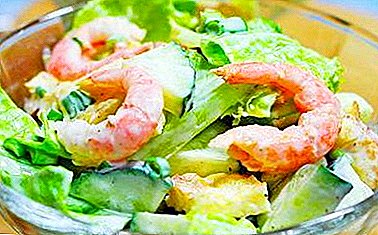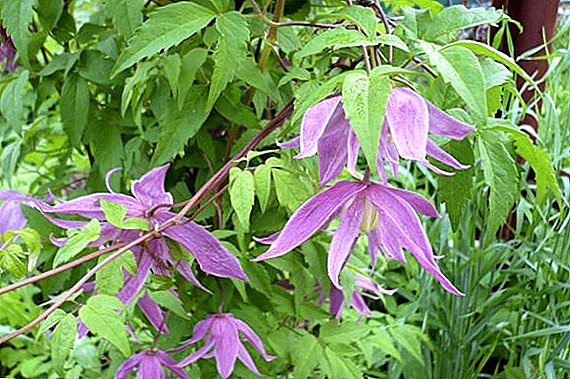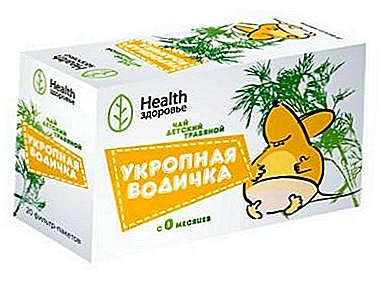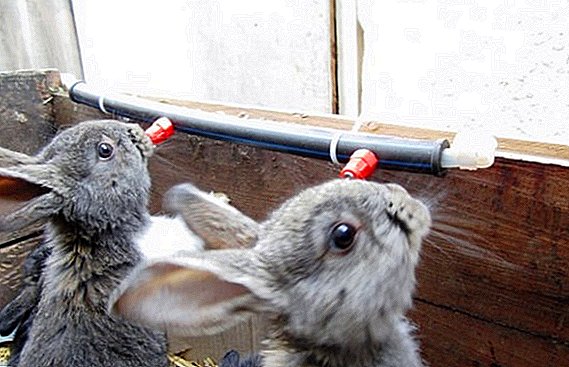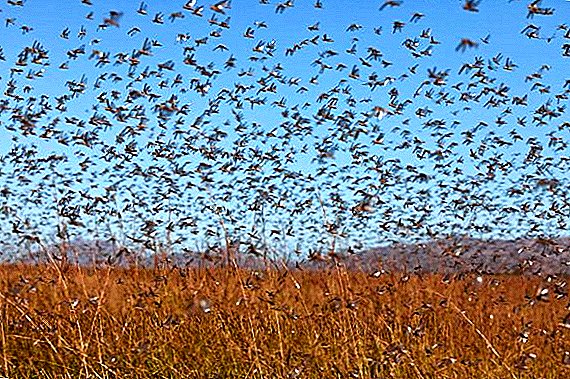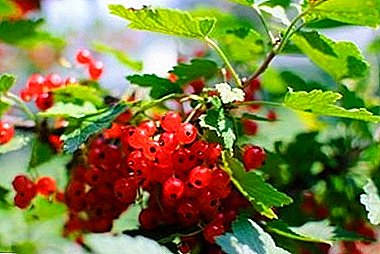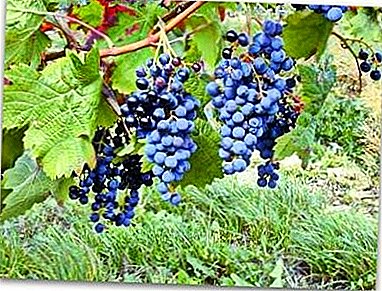 Star anise and anise are spices that are widely used in cooking, medicine and cosmetology. On the characteristics of spices, scope, benefits and contraindications of use, read below.
Star anise and anise are spices that are widely used in cooking, medicine and cosmetology. On the characteristics of spices, scope, benefits and contraindications of use, read below.
Description of the badian
Badian, belongs to the genus of flowering crops, family Limonnikovyh. The plant is an evergreen tree, reaching a height of 10 m. The top of the tree has a pyramidal shape. The leaf plates are lanceolate, green in color, reaching sizes up to 10 cm. Floral ovaries can be yellow or light green. 
Bracts consist of 18 lobes - where the outer ones are obovoid, and the inner ones are narrow-lanceolate. When a tree reaches 5 years old, the fruit begins to ripen; they look like stars with 8 or 12 rays.
The fruits consist of dense single-seeded leaflets, collected around the axis, as they ripen, they mature as they mature. Many spice consumers confuse star anise and anise, because of the similarity of flavors. In the people Badyan even dubbed the name - "star anise."
Important! Fruits of a badian become fit for human consumption, only for the 15th year of the tree’s life.
Spice Differences:
- Badian grows in India, China, Japan and is a perennial tree, and anise grows in Europe and America, belongs to the representatives of annual crops.
- Anise - has no toxic varieties, the badian has poisonous varieties, such as: wild dummy or thick-leaved.
- Badyan fruit is sweet in taste, has a delicate touch of bitterness, and it also contains sharpness and astringent aftertaste, its bouquet is delicate, rich. Anise has a spicy smell, the taste of its fruit is vaguely reminiscent of fennel and has a sweet taste with a spice element.
Anise features
One-year, grassy culture, cultivated in warm latitudes. Grown on a massive scale for use in cooking and pharmaceuticals. Culture belongs to the family of umbrella and the structure resembles dill.

The culture reaches a height of 50 cm and has thin, pubescent stems that branch at the top. The root system is thin, it looks like a rod that has no branches. The lower leaf plates are rounded in shape, have long petioles, they grow from the rhizome. In the upper and middle parts of the plant the leaves are smaller, having a wedge-shaped back.
Did you know? To achieve a good bite, the fishermen grease the gear with anise extract, which attracts the fish with its spicy aroma.
Flowers are presented in the form of umbrellas, with a diameter of not more than 6-7 cm. Each inflorescence holds up to 17 flowers. Flowering begins from the end of June and lasts until October, during this period the formation of fruits occurs. The fruit is an egg-shaped seed flattened at the sides. The length of anise seeds 5 mm, color gray.
The origin of two plants
Anise is the oldest spice that people began to cultivate. It is not known exactly where they started growing the crop first, but in the descriptions of Hippocrates there is information about its healing properties. There is an assumption that the spice began its distribution throughout the world from the Mediterranean. The ancient Romans worshiped the seasoning and mixed it in the cakes, which were used to normalize digestion.

The southern and western parts of China are considered to be the birthplace of the Badian. In Europe, the seasoning was brought in the XVI century, then the spice became popular in the countries of India, Vietnam and Japan.
Beneficial features
Spices are widely used in various kinds of dishes, and also due to their vitamin composition they are used in traditional medicine. About the benefits of the products in question, see below.
Badiana
Useful properties of spices, are in its chemical composition, which includes vitamins and minerals.
Did you know? King Edward I of England, in 1305, imposed a tax on the sale of anise, the proceeds of which were directed to the repair and maintenance of the London Bridge.
Chemical composition per 100 g of product:
- proteins - 18 g;
- fats - 16 g;
- carbohydrates - 50 g
Vitamins and minerals:
- retinol;
- thiamine;
- riboflavin;
- a nicotinic acid;
- pantothenic acid;
- vitamin C;
- pyridoxine;
- choline;
- zinc;
- manganese;
- selenium;
- fluorine.
The beneficial properties of spices significantly affect the strengthening of immunity, which provides vitamin C. Retinol is part of, improves eyesight. B vitamins, a positive effect on the cardiovascular and nervous systems in the body.

The use of spices in food will help to settle the unstable menstrual cycle in women, and also due to the antispasmodic effect will reduce pain in the lower abdomen during menstruation. The benefits of spice for men are to increase sexual desire and eliminate discomfort when urinating, in the form of pulling pains.
Anise
Chemical composition per 100 g of product:
- proteins - 17.6 g;
- fats - 15.9 g;
- carbohydrates - 35.4 g;
- dietary fiber - 14.6 g
Vitamins and minerals:
- magnesium;
- sodium;
- iron;
- zinc;
- retinol;
- vitamin C;
- choline;
- a nicotinic acid;
- pantothenic acid;
- thiamine;
- riboflavin.
Important! Anise seeds are a natural antidepressant, so they are recommended to be added to dishes 2-3 g with neurosis and apathetic mood.
The spice of anise, used in food, can have an antiseptic and analgesic effect. The use of medicines based on spices, improves the functioning of the stomach, has a positive effect on the nervous system, by normalizing sleep and eliminating anxiety.
Useful properties of spices are rich in vitamins B, C, A, which help in the fight against viral diseases. Medicinal preparations based on spices, have an expectorant and antiseptic effect, which helps with bronchitis and sore throat.

Application features
Seasonings have a wide range of applications in:
- cooking;
- cosmetology;
- traditional medicine.
In cooking
Badian is a tasty and fragrant spice that is used in many dishes.
Most often, for a variety of taste, spice is combined with such spices:
- fennel;
- cinnamon;
- carnation;
- black pepper.
Find out if cumin and dill are the same plant.
The use of badian in dishes:
- Seasoning is put in drinks and jams, for better taste and aroma, usually put 2 asterisks on 1.5 l of liquid.
- In meat dishes used spice in the consistency of coarse powder.
- Milled spice together with garlic and pepper, added to sauces for rice, egg and vegetable dishes.

The use of anise in cooking:
- Fresh anise leaves are put in salads, decorated with first and second courses.
- Leaf plates are added to fermented milk products and included in sauces for second courses.
- Meat and fish dishes are seasoned with a mixture of spices from: anise, cumin, milled pepper and bay leaf.
- Spice is added to cream soup made from broccoli and beans.
- Anise in combination with coriander and cumin, great for adding to the dough when baking bread.
In folk medicine
The use of the fruit of the alley as a solution has an antispasmodic effect, and also helps with diarrhea.
Read also about the features of coriander seeds and their use.
Preparation and application of the solution:
- Take 20 g of chopped fruit of the badian and pour 500 ml of boiling water.
- Wrap a container of liquid with a towel and infuse for 60 minutes.
- Take 100 ml of the solution 3 times a day for 48 hours, until symptoms are relieved.
Prevention and removal of worms:
- Badin root 20 g, finely chop and pour 250 ml of boiling water.
- Insist for 30 minutes. and cool.
- Take 1 tablespoon per day on an empty stomach for 1-2 weeks.
To eliminate pain in the stomach, you can use the tincture of the fruit of the bayena:
- In 250 ml of vodka, place 3 fruits of the star anise.
- Infuse for 7 days in a dark, cool room.
- Take with acute stomach pains of 30 g.
Slimming tea, with the addition of the fruit of the star anise:
- In the capacity for brewing tea, put 2 badyan fruit and cinnamon stick.
- Brew black tea and pour the tea in a container with spices.
- Infuse the tea for 5 minutes, add 20 g of honey to the cup if desired.
Anise seeds in the infusion are excellent help from colds. Infusion is used as an expectorant for wet cough and bronchitis.

Method of preparation and use:
- Seeds of anise 30 g, pour 500 ml boiling water.
- Capacity for infusion wrap a towel and infuse for an hour.
- Infusion strain through cheesecloth and use 30 g 3 times a day for 4-5 days.
Excellent remedy for flatulence and stomach cramps:
- Anise seeds 20 g, brewed in 200 ml of boiling water.
- Cooked decoction, pass through a sieve and use 100 ml in the morning and evening hours for 3 days.
To get rid of pharyngitis and hoarseness, you need to make the following decoction:
- Chopped anise 30 g per 250 ml of boiling water and 20 g of honey in May.
- Heat the spice for a couple of 15 minutes.
- Pass the decoction through a sieve and add honey. Take 30-40 g 5 times a day.
In cosmetology
For cosmetic purposes, spices are used in the form of an essential oil, on the basis of which they make various face and body masks. Infusions of anise and star anise, used as a tonic for the skin.

Due to the high content of vitamin A and potassium, anise extract acts on the deep layers of the skin, removing the tone, which leads to a smoothing effect and the disappearance of fine, mimic wrinkles.
Essential oils of anise and star anise are successfully used in cosmetic gels for showering. Anise oil 2 drops, pour 200 ml container shampoo - this will promote the proper growth and development of hair follicles, and will also make your hair silky.

The mask for rejuvenation and elasticity of the skin is made from:
- 60 g sour cream 20% fat;
- 1 g of oil of badian;
- 30 g of honey.
Important! When using an essential oil of a magnolia, it is necessary to observe proportions with accuracy, otherwise you can get a skin burn.
To overcome cellulite, apply a massage with olive oil of 30 g, in which the badian’s essential oil is put 2 g. It is necessary to rub and massage the skin in problem areas on the stomach and legs for 15 minutes. Oil can not rinse, and leave to soak into the skin.
Moisturizing gel face mask:
- Beeswax 50 g, melt on the steam bath.
- Add 110 ml of olive oil heated to + 40 ° С to melted wax.
- Mix 250 g of aloe pulp into the mixture.
- Add 3 g of anise oil.

The gel mask is used in the care of dry, fading skin of the face and neck, and also has a healing effect on minor scratches and cracks, when applied on the feet and elbows.
Possible contraindications
Contraindications and harm to the body when applying badin:
- Spice is contraindicated in breastfeeding, due to possible toxic effects.
- Spice leads to dehydration, when combined with dill and lingonberry leaves.
- Individual intolerance spices.
Important! When using badyana, in cooking, you must clearly adhere to the dosage. An oversupply of seasoning will lead to general intoxication of the body, causing nausea and vomiting.
Contraindications when using anise:
- Breastfeeding period in women in labor.
- Allergic reaction to the spice.
- Diseases of the stomach in the acute stage.



